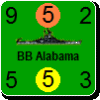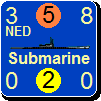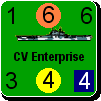Daniele
Posts: 1812
Joined: 2/7/2015
Status: offline

|
Chapter 5 German Buildup in the East
Where To Next?
After capturing Paris and declaring Vichy in May/June 1940, the Axis needed to decide whether to go west, south, or east.
West to the United Kingdom seemed high risk. There wasn’t enough German sea lift (1 naval transport and 1 amphibious unit) to get a lot of units across the North Sea quickly. A few divisions, a paratrooper, and a couple of corps sized units could get there in the first wave. Having the sea lift return to port and be reorganized by an HQ could let a couple more corps be ferried across to the UK in the same turn. It might even be possible to repeat the trick and reorganize them a second time to get a fifth and sixth corps across by the end of July/Aug 1940.
Expecting the Commonwealth to stand idly by and watch all that happen would have been delusional. G had kept a handful of land units in England and Scotland. There were a half dozen British air units present as well. More hazardous to the well-being of the German army was the British navy, which could cut off supply to the Axis soldiers in England from the German homeland. In particular, if the British had one good set of naval search rolls in the North Sea (low Allied roll and high Axis roll), one or both of the essential two Axis sea lift units could be lost at sea. Making the attempt to take out the United Kingdom was doable. I wasn’t confident of it being a successful attempt though.
South to Gibraltar to isolate the Mediterranean from the Allies was also a potential direction for the German forces currently massed in France. To start, Germany would have collapsed Vichy and moved its armies and air force down to the border with Spain. Then a DOW on Spain and a fight through the mountains on the border would have followed. Slogging through the rest of Spain to reach the hexes around Gibraltar would have taken to the end of July/Aug 1940 - at best. In the fall (Sept/Oct), the weather is pretty nice in the Med, so conducting some attacks on Gibraltar could probably have been done in the following turn. But the Rock is a tough nut to crack. Putting the Allied units there out of supply is pretty much required.
That means the Axis has to control both the Western Med and the Cape St. Vincent sea areas. The Italian navy and air force, with help from the German air force, might be able to drive the British out of the Western Med. In this game I was able to do that for one turn, by having Italy DOW the Commonwealth and using the subsequent surprise impulse to get a bunch of surprise points for the naval combat. But soon the British were back in strength. Doing the same in Cape St. Vincent would have required the German naval forces to move to the French ports on the Bay of Biscay then on to Cape St. Vincent. Operationally that would have required several naval moves for Germany, and a significant amount of luck at sea. Those pesky Brits would have gotten in the way I am sure. If all went well and Gibraltar fell, then perhaps the USSR could have been attacked in 1942. All in all, it would have been another plan with high risk.
Of the three compass directions, going east was my preference. It did not engender the risk of bad search rolls at sea sending the entire operation down the drain. Staying on terra firma, the German army could take on the Russian army face to face. There would be no coastal hexes in the path of the advance, where the Commonwealth could double the defensive factors of enemy land units. To take on the USSR meant building up a massive German force along the border.
Breaking the Nazi-Soviet Neutrality Pact
It wasn’t until late in the Mar/Apr 1941 turn that the relative garrison levels along the Axis-Soviet border and the weather were favorable for Germany breaking the Nazi-Soviet Pact. It had taken extensive planning and resources for the Germans to generate a sufficient garrison level to break the Nazi-Soviet pact. In Figure 5-1 you can see the option to break the pact was offered to Germany in the DOW Majors phase of the 11th impulse of the Mar/Apr 1941 turn. I did so. And then I had both Germany and Italy declare war on the USSR.

The German garrison level was 102 plus 36 in offensive markers. Compared to that was the USSR garrison level of 43.5 plus 22 defensive markers. 138:65.5 is greater than 2:1, so Germany could break the pact. Another 4 garrison points for the USSR and breaking the pact would not have been possible. The USSR had units worth 6 garrison points available that were either disorganized or not close enough to the border. Why weren’t they organized and closer? Because offensive markers are never shown to the other side. The values of defensive markers are visible to both sides. Disorganized units do not count towards garrison levels.
Germany had to drag every unit with garrison factors to within 3 hexes of a hex controlled by the USSR. Italian units didn’t count, so they were primarily placed in occupied countries (i.e., France and Yugoslavia) to prevent partisans from arriving. But units belonging to minor countries aligned to Germany did count towards the garrison level, so they all journeyed to the critical border area. In the end, I had the entire German air force desert their posts protecting Axis factories and rebase east to the garrison zone. These extreme measures just barely got the job done.
While this was a tense time for the Axis, it was equally stressful for the USSR. Having all its forces so close to the border put them in danger of being overwhelmed by the German blitz. According to the rules, Germany gets two neutrality pact markers each turn and the USSR gets one. In theory, the total value of those markers should be 2:1 in favor of Germany. In this game, they were far from that. Either Germany should have had 44 points in markers or the USSR should have only had 18. From G’s point of view, if the German markers were worth 39 instead of 36, the USSR getting 5 more garrison points closer to the front wouldn’t have prevented Germany from breaking the pact. This was all a very hairy time for both sides.
As it turned out, Germany had sufficient garrison points to break the pact at any time during the Mar/Apr 1941 turn. But the weather wasn’t Fine in the Arctic weather zone. So I held off. The benefits of surprise from a DOW only lasts for one impulse and most of that would have been wasted by starting the war when the weather was Rain, Storm, or even Snow. So I waited, and G waited, both of us biting our nails, until the 11th impulse of the turn.
G says: Yes, this is a very difficult situation for Russia. Keep your forces close to the border and risk getting surrounded, or pull back just in the nick of time. For Russia to survive it must try to save as many units as possible during 1941.
German Forces in the North
I was planning to attack Russia from as far back as the end of 1939. Which units I built and where they would be positioned were worked out in advance. Every turn I revisited the plan and modified it due to losses in combat and build points lost to strategic bombers. Cobbling together garrison points and finding places for all those units along the front required continual adjustments.
Figure 5-2 shows the disposition of Axis forces in the north just before the DOW. The dashed turquoise line indicates the separation of the northern forces from the Axis forces in the center. Those starting in the row with Brest-Litovsk and above were destined to go north.

Looking at the HQs, there is von Bock, Rommel, and von Leeb dedicated to keeping the Axis units in supply. I chose the slower moving HQs, von Bock and von Leeb for the north because they don’t need to travel as far to reach the Soviet forces as those going through the Ukraine. Rommel was added partially because he arrives late in the war, and to provide an armor HQ to reorganize armor and mechanized units at a cost of only 1 reorganization point. Most of the units in the north are infantry. The 4-2 artillery and 2-3 AT units were placed in the north because they had small movement allowances. Infantry units with only 3 movement points were almost all placed in the north for the same reason.
For the air force, the short range Stukas were all placed in the north. A couple of longer range bombers were present, including an Italian naval air unit. The last is a flying boat (as denoted by the blue circled number in the upper right) and had to be based in a coastal hex. Supply for that unit couldn’t have been provided by the Rumanian capital or HQ, so placing it near German supply sources was paramount.
In combat factors, the Axis totals were 156 land (29 armor/mechanized) and 25 tactical air. In addition there were 3 ‘pure’ fighters. Some of the units in the front were destined to rail to the rear to garrison occupied countries. Likewise some of the fighters needed to head back west to protect factories against strategic bombing. But those were the exceptions. Everyone else’s orders were to move east and attack Russians.
German Forces in the Center
Figure 5-3 shows the disposition of the Axis forces in the center. Here the two HQs are Guderian and Graziani. Both are armor HQs but Graziani only has 3 movement points. Another encumbrance on Graziani moving east is that Italy will often take a Combined Action to make its naval units active. That will leave the Italians capable of moving only two land units.

Note the movement points for all the units in the center. Except for the Italians, a garrison and a militia unit, none of them has less than 4 movement points. Indeed, the armor and mechanized units, for the most part, have 6 movement points. They’ve got a lot of ground to cover to reach Kiev and the Dnieper. Perhaps they will find some Russian units to run over along the way.
Very few air units were deployed in the center. The jumping off hexes were simply too far away from USSR units for air units placed here to do any good. The fighters had just rebased here from central Germany and would soon be heading back from whence they came.
Counting the sheer number of units, the center had fewer than the north. But these were good units: 90 total combat factors, of which 51 were armor/mechanized, and 12 others with 5 movement points. This force was able to move quickly through the Ukraine and do damage to any enemy forces in their way. Realistically, I expected the units in the center to quickly link up with those in the south, and the combined forces to function as a whole.
German Forces in the South
Figure 5-4 displays the Axis units in the southern force, as separated from the center force by the dashed turquoise lines. The 5-4 and 7-4 infantry units in the upper left were assigned to the center because they were going to head northeast before turning due east. All the rest of the units shown here were in Rumania or Hungary.

The two Hungarian infantry and the nearby four Rumanian corps were not intended to attack into Russia. Instead, they were staying in their home countries, to satisfy the restriction that many units belonging to aligned minor countries cannot wander outside their countries’ borders. In practice, they performed double duty, by moving adjacent to the border with Yugoslavia and thereby exerting a zone of control into Yugoslavia, helping to discourage the creation of Yugoslavian partisans. At the moment, they are close enough to the USSR controlled hexes in eastern Poland to count toward Germany’s garrison level along the border. The Italians in Belgrade will head east once the pact is broken and the minor country units have moved back to take over the garrison duties.
Getting all those units into Rumania wasn’t easy. The mountains in the middle of Rumania made walking there from the west time consuming, especially when the weather turn nasty. Short turns with only a couple of impulses per side didn’t help either. So, many of them railed into Rumania. When the railed units were armor, mechanized, or motorized, that necessitated expending oil later to reorganize them. Playing with the optional Oil rules puts the Axis at a disadvantage since they have so few oil resources. You might notice that a couple of the German units are disorganized. That’s because they railed in earlier in the turn. If bad weather had persisted through to the end of the turn, then they would have been reorganized at the end of the turn (zero oil cost) and contributed to the garrison value at the start of the next turn.
The German front line here is very crowded. Two corps in every hex, often a divisional unit too, maxing out the stacking limit. On top of the land units in each hex are air units, with 3 air units (maximum stacking) in the sole city in the front. Of major importance for this deployment in Rumania was the fact that G had not claimed Bessarabia. The extra 8 hexes were put to good use. Besides placing the Axis forces closer to the Dnieper and other points east, controlling the two cities in Bessarabia with Axis units reduced the number of required Assault attacks the Germans would have to conduct before getting into the USSR proper. I had expected G to claim Bessarabia, thereby taking over Cernauti (the hex holding 3 oil points) and Chisinau (the hex with 3 air units).
There were two HQs in the south: Rundstedt and Antonescu. Rundstedt was the slowest moving armor HQ, so I placed him closer to the Dnieper. Looking at the total combat factors, and excluding the 6 minor country units moving southwestward, there are 113 land (36 armor/mechanized, plus 10 motorized) and 39 tactical air. When the center joins up, there will be 203 land combat factors, of which 87 will be armor/mechanized, advancing on the Russian forces in the Ukraine. The south has only 1 ‘pure’ fighter and he will stay behind to protect the oil resources in Ploesti from strategic bombing by the Brits in Greece. This is where the longer range Axis bombers were placed. Ground strikes and ground support are an essential element of the German blitzkrieg. The air transport with his ever present paratroop unit were also here - just to make the Allied player nervous.
Conclusion
All tolled, the Axis had assembled 359 land combat factors with 64 tactical air factors to initiate Barbarossa. Getting to start it in Mar/Apr was a big bonus. That not only gave them an extra impulse of Fine weather for the campaign, it also meant that the whole air force could fly missions and then be reorganized at the end of the turn - so they would be fresh as a daisy at the start of the May/June turn.
In overview, the Axis spread out their HQs and armor/mechanized units over all three groups. Care was taken as to which units were placed where, considering not only unit types, but also their movement points and combat factors. Even little details, like putting the mountain units in the north for later attacks against Leningrad in the far future (mountain units gain a +1 DRM when attacking in Snow weather) were attended to. The north was also heavy with infantry units because they only pay one movement point to move into Forest hexes, while motorized units pay two. A 6-3 infantry could move 3 hexes through the woods, while a 9-5 mechanized could only move two. In the same vein, the cavalry unit was in the center. It had 5 movement points, just enough to move into a swamp terrain hex in the Pripet Marshes without becoming disorganized. Only cavalry have that ability. Attention to all these little details made the German armed forces much more powerful than they would have been if which units were assigned where had been done haphazardly.
G says: It was obvious where the Axis main attack was coming, in the south. The Axis wanted to advance fast in the south to get to the Caucasus oil, and if really lucky, to reach the Turkish border to bring in Turkey on the Axis side. That’s why you see the best Russian units in the south. When pulling back from the border, the Russian units should try and keep out of Stuka range - without giving up too much territory.
The next post covers the Russian side of this front.
|
 Printable Version
Printable Version

















 New Messages
New Messages No New Messages
No New Messages Hot Topic w/ New Messages
Hot Topic w/ New Messages Hot Topic w/o New Messages
Hot Topic w/o New Messages Locked w/ New Messages
Locked w/ New Messages Locked w/o New Messages
Locked w/o New Messages Post New Thread
Post New Thread